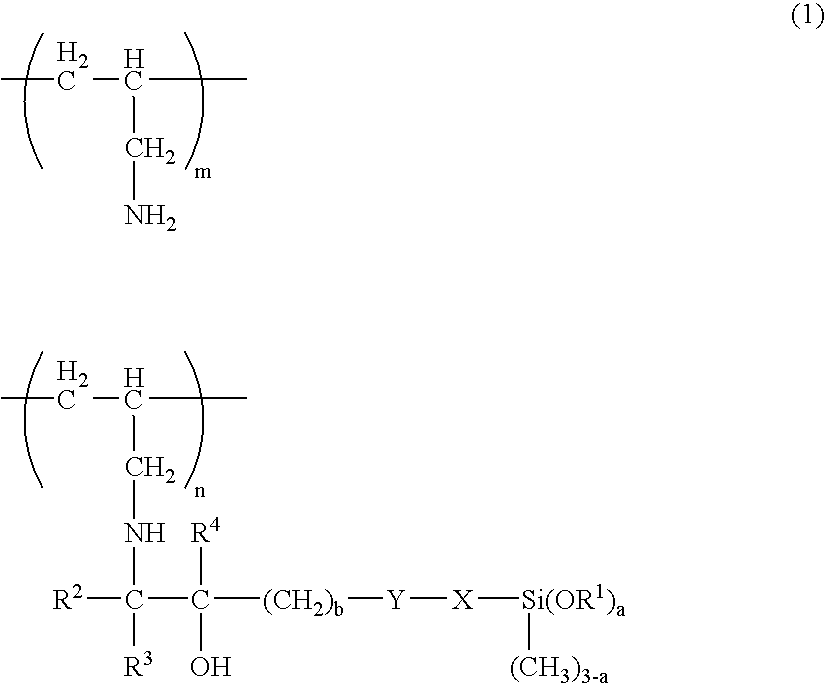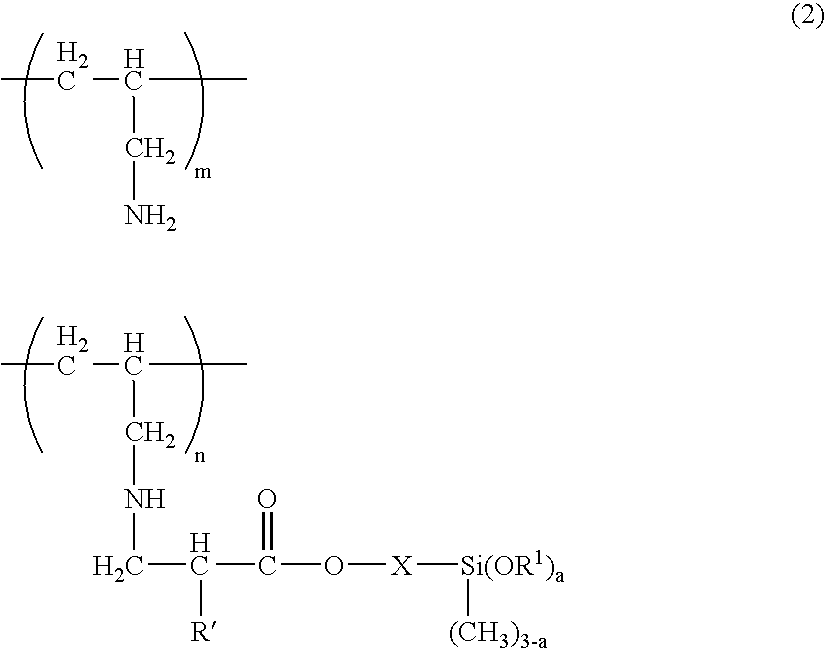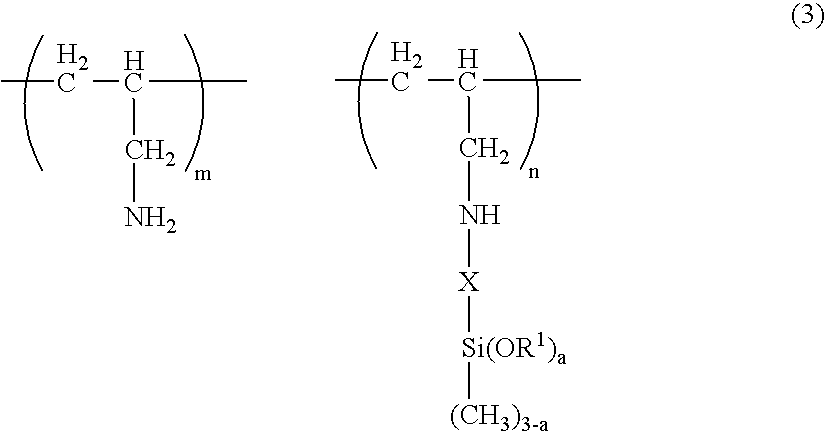Metal surface treating agent, surface treated steel material and treating method, and coated steel material and its production method
a metal surface treatment and treatment method technology, applied in the direction of pretreatment surfaces, metallic material coating processes, anti-corrosion paints, etc., can solve the problems of high probability of restricted use of metal surface treatment agents, system insufficient workability and adhesion to the underlying substrate, corrosion resistance of this system, etc., to achieve the effect of improving coating workability
- Summary
- Abstract
- Description
- Claims
- Application Information
AI Technical Summary
Benefits of technology
Problems solved by technology
Method used
Image
Examples
synthetic example 1
[0083]Moisture was removed from 500.0 parts by weight of 15% by weight aqueous solution of polyallylamine [PAA-01 manufactured by Nitto Boseki Co., Ltd. having an average molecular weight of 1000] under reduced pressure, and methanol was added for solvent exchange to prepare a 15% by weight methanol solution. To this solution was added 77.9 parts by weight (0.33 mole) of 3-glycidoxypropyltrimethoxysilane, and the mixture was stirred at 60° C. to 70° C. for 5 hours. Since the 3-glycidoxypropyltrimethoxysilane (the starting material) is consumed with the progress of the solution, the solution was measured by gas chromatography, and no peak of the 3-glycidoxypropyltrimethoxysilane (the starting material) was detected. When silicon was measured by NMR, the signal detected was not the signal of the 3-glycidoxypropyltrimethoxysilane but the signal presumably of the target compound. Based on the information as described above, the reaction was confirmed to have been completed, and the solu...
synthetic example 2
[0084]Moisture was removed from 500.0 parts by weight of 20% by weight aqueous solution of polyallylamine [average molecular weight, 2500] under reduced pressure, and methanol was added for solvent exchange to prepare a 15% by weight methanol solution. To this solution was added 101.5 parts by weight (0.43 mole) of 3-glycidoxypropyltrimethoxysilane, and the mixture was stirred at 60° C. to 70° C. for 5 hours. Since the 3-glycidoxypropyltrimethoxysilane (the starting material) is consumed with the progress of the solution, the solution was measured by gas chromatography, and no peak of the 3-glycidoxypropyltrimethoxysilane (the starting material) was detected. When silicon was measured by NMR, the signal detected was not the signal of the 3-glycidoxypropyltrimethoxysilane but the signal presumably of the target compound. Based on the information as described above, the reaction was confirmed to have been completed, and the solution was diluted with methanol to adjust the content of t...
synthetic example 3
[0085]Moisture was removed from 500.0 parts by weight of 20% by weight aqueous solution of polyallylamine [average molecular weight, 700] under reduced pressure, and methanol was added for solvent exchange to prepare a 15% by weight methanol solution. To this solution was added 99.1 parts by weight (0.42 mole) of 3-glycidoxypropyltrimethoxysilane, and the mixture was stirred at 60° C. to 70° C. for 5 hours. Since the 3-glycidoxypropyltrimethoxysilane (the starting material) is consumed with the progress of the solution, the solution was measured by gas chromatography, and no peak of the 3-glycidoxypropyltrimethoxysilane (the starting material) was detected. When silicon was measured by NMR, the signal detected was not the signal of the 3-glycidoxypropyltrimethoxysilane but the signal presumably of the target compound. Based on the information as described above, the reaction was confirmed to have been completed, and the solution was diluted with methanol to adjust the content of the...
PUM
| Property | Measurement | Unit |
|---|---|---|
| structures | aaaaa | aaaaa |
| structure | aaaaa | aaaaa |
| water-soluble | aaaaa | aaaaa |
Abstract
Description
Claims
Application Information
 Login to View More
Login to View More - R&D
- Intellectual Property
- Life Sciences
- Materials
- Tech Scout
- Unparalleled Data Quality
- Higher Quality Content
- 60% Fewer Hallucinations
Browse by: Latest US Patents, China's latest patents, Technical Efficacy Thesaurus, Application Domain, Technology Topic, Popular Technical Reports.
© 2025 PatSnap. All rights reserved.Legal|Privacy policy|Modern Slavery Act Transparency Statement|Sitemap|About US| Contact US: help@patsnap.com



